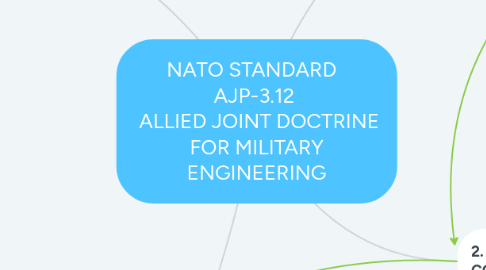
1. 3. MILITARY ENGINEERING PLANNING
1.1. Planning at the strategic level
1.2. Planning at the operational level
1.2.1. Phase 1 –Situation awareness
1.2.2. Phase 2 – Operational-level appreciation of SACEUR’s Strategic Assessment
1.2.3. Phase 3 - Operational Orientation
1.2.4. Phase 4 A - Operational CONOPS development
1.2.5. Phase 4 B – Operational-level plan development
1.2.6. Phase 5 – Execution, campaign assessment / OPLAN review
1.2.7. Phase 6 - Transition
1.3. Military engineering planning relations to other functional areas and the host nation
1.3.1. MILENG and Geospatial
1.3.2. MILENG and Targeting
1.3.3. MILENG and Civil-Military Cooperation (CIMIC)
1.3.4. MILENG and Logistics
1.4. Special considerations for military engineer planning
1.4.1. Funding Mechanisms
1.4.2. NATO Security Investment Programme (NSIP)
1.4.3. Military Budget
1.4.4. Funding Requests
2. 4. MILITARY ENGINEERING SUPPORT TO THE CONDUCT OF ALLIED JOINT OPERATIONS
2.1. Military engineering support during all stages of allied joint operation
2.1.1. Intelligence preparation of the operational environment and operations planning
2.1.2. Preparation of the force, including (logistic) build-up
2.1.3. Deployment
2.1.4. Execution of Operations
2.1.5. Operation (mission) termination and transition
2.1.6. Redeployment of the force
2.1.7. Operation/campaign assessment – doctrine evaluation and lessons learned
2.2. Military engineering support to air operations
2.2.1. General
2.2.2. Planning and execution
2.3. Military engineering support to maritime operations
2.4. Military engineering support to special operations
2.5. Military engineering support to logistics
2.6. Specific considerations for operations
3. 1. PRINCIPLES
3.1. Comprehensive approach
3.2. Implications for military engineering
3.2.1. Effective MILENG
3.2.2. Planning relations
3.2.3. Stabilization and reconstruction (S&R)
3.2.4. Disaster Relief
3.3. Scope of military engineering
3.4. Military engineering at the different levels
3.4.1. Strategic Level
3.4.2. Operational Level
3.4.3. Tactical Level
3.5. Military engineering forces and resources
4. 2. MILITARY ENGINEERING COMMAND AND CONTROL
4.1. Military engineering command and control principles
4.2. Military engineering command and control principles in SHAPE
4.3. SHAPE engineer staff organization
4.4. Military engineering command and control principles in joint force headquarters
4.5. Joint force engineer staff organization
4.5.1. JFENGR
4.5.2. Engineer Plans Branch
4.5.3. Engineer Operations Branch

